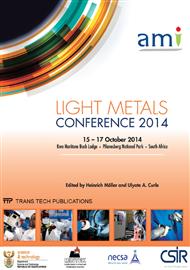[1]
W. van Tonder, South African Titanium: Techno-Economic Evaluation of Alternatives, Dissertation M. Sc., Stellenbosch University, SA, (2010).
Google Scholar
[2]
SAIMM, The South African Institute of Mining and Metallurgy, http: /www. saimm. co. za/saimm-events/upcoming, accessed 10 May (2014).
Google Scholar
[3]
CSIR, http: /www. csir. co. za/msm/metals_and_metals_processes/overview. html accessed 10 May (2014).
Google Scholar
[4]
Information on http: /41. 72. 145. 110/lightmetals2014. co. za.
Google Scholar
[5]
S. Bose, High Temperature Coatings, Elsevier, NY, (2007).
Google Scholar
[6]
RTO-EN-14, Aging Engines, Avionics, Subsystems and Helicopters, Research and Technology Organization, North Atlantic Treaty Organization (NATO), (2000).
Google Scholar
[7]
M. Bender and D. J. Wells, Fleet Supportability and Aging Aircraft, Air Line Pilots Association, International, Herndon, VA 20172, (2004).
Google Scholar
[8]
B. Cantor, H. Assender, and P. Grant, Aerospace Materials, IOP Publishing Ltd., Bristol (2001).
Google Scholar
[9]
J. Hirsch and T. Al-Samman, Superior light metals by texture engineering: Optimized aluminium and magnesium alloys for automotive applications, Acta Materialia 61 (2013) 818–843.
DOI: 10.1016/j.actamat.2012.10.044
Google Scholar
[10]
G. Berube, M. Yandouzi, A. Zuniga, L. Ajdelsztajn, J. Villafuerte, and B. Jodoin, Phase Stability of Al-5Fe-V-Si Coatings Produced by Cold Gas Dynamic Spray Process Using Rapidly Solidified Feedstock Materials. J of Thermal Spray Technology 21 (2012).
DOI: 10.1007/s11666-011-9716-z
Google Scholar
[11]
J. Villafuerte and W. Zheng, Corrosion Protection of Magnesium Alloys by Cold Spray, Advanced Materials & Proceses September: (2007) 53-54.
Google Scholar
[12]
A. Papyrin, V. Kosarev, S. Klinkov, A. Alkimov, and V. Fomin, Cold Spray Technology, Elsevier Ltd, (2007).
DOI: 10.1016/b978-008045155-8/50004-1
Google Scholar
[13]
T. Schmidt, H. Assadi, F. Gartner, H. Richter, T. Stoltenhoff, H. Kreye, and T. Klassen, From Particle Acceleration to Impact and Bonding in Cold Spraying, Journal of Thermal Spray Technology, 18 (2009) 794-809.
DOI: 10.1007/s11666-009-9357-7
Google Scholar
[14]
P. F. Leyman and V. K. Champagne, Cold Spray as a Portable Repair Process for Aluminium Aerospace Alloys, US Army Research Laboratory, Weapons and Materials Research Directorate, Aging Aircraft Conference (2008).
Google Scholar
[15]
V. K. Champagne, The Repair of Magnesium Rotorcraft Components by Cold Spray, Journal of Failure Analysis and Prevention, 8 (2008) 164-175.
DOI: 10.1007/s11668-008-9116-y
Google Scholar
[16]
H. Nakajima, Fabrication, properties and application of porous metals with directional pores. Progress in Materials Science, 5 (2007) 1091–1173.
DOI: 10.1016/j.pmatsci.2006.09.001
Google Scholar
[17]
J. P. Arenas, M. J. Crocker, "Recent Trends in Porous Sound-Absorbing Materials, sound & vibration, 2010, information on www. SandV. com.
Google Scholar
[18]
W. Liu, W. Zhang, N. Li, J. Zheng, S. An, and G. Li., Influence of Dealloying Solution on the Microstructure of Monolithic Nanoporous Copper through Chemical Dealloying of Al 30 at. % Cu Alloy, International Journal of Electrochemical Science, 7 (2014).
DOI: 10.1016/j.corsci.2010.11.017
Google Scholar
[19]
M. Tiemann, Concepts Chemistry - A European Journal, Wiley-VCH Verlag GmBh & Co. KGa A, Weinheim, Germany, 13 (2007) 8376-8388.
Google Scholar
[20]
B.V. Krishna, W. Xue, S. Bose and A. Bandyopadhyay, Engineered Porous Metals for Implants, Development in Titanium, overview, (2008), Information on JOM 45 www. tms. org/jom. html.
DOI: 10.1007/s11837-008-0059-2
Google Scholar
[21]
P. J. Bridges and B. Magnus, Manufacture of Titanium Alloy Components for Aerospace and Military Applications¸ RTO AVT Specialists' Meeting on Cost Effective Application of Titanium Alloys in Military Platforms, Norway, (2001).
Google Scholar
[22]
G. Ryan, A. Pandit and D. P. Apatsidis, Fabrication methods of porous metals for use in orthopaedic applications - Review, Biomaterials, 27 (2005). 2651-2670.
DOI: 10.1016/j.biomaterials.2005.12.002
Google Scholar
[23]
A. Bhattacharya and R. L. Mahajan, Metal Foam and Finned Metal Foam Heat Sinks for Electronics Cooling in Buoyancy-Induced Convection, Journal of Electronic Packaging, 128/259, ASME, (2006).
DOI: 10.1115/1.2229225
Google Scholar
[24]
Z. Wojciech, S. Stanislaw and T. Jarmila, Tribological Properties of Hypersonically Sprayed Carbide Coatings, 36 (2008) 81-86, Belgrade.
Google Scholar
[25]
D. Lioma, N. Sacks, I. Botef, Cold gas dynamic spraying of WC-Ni cemented carbide coatings, at 10th International Conference on the Science of Hard Materials, Mexico, (2014).
DOI: 10.1016/j.ijrmhm.2014.08.017
Google Scholar


